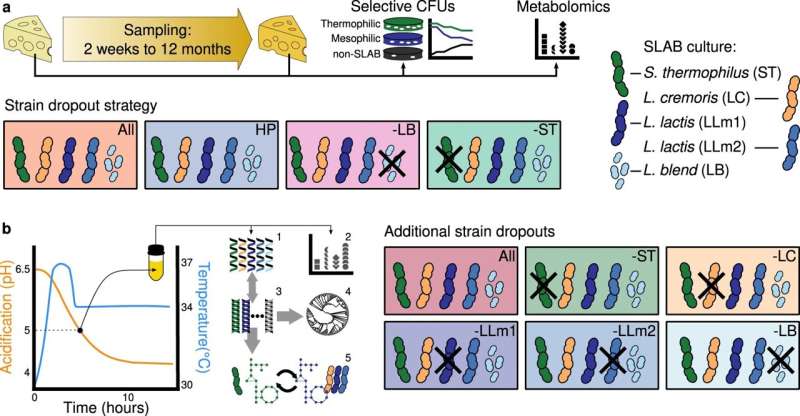This article has been reviewed according to Science X's editorial process and policies. Editors have highlighted the following attributes while ensuring the content's credibility:
fact-checked
peer-reviewed publication
trusted source
proofread
Investigating how microbial interactions shape Cheddar cheese's flavor profile

The combinations of microorganisms responsible for shaping the taste of Cheddar cheese—including fruity, creamy, buttery, and nutty flavors—are investigated in a Nature Communications paper.
Cheese fermentation and flavor formation are influenced by complex biochemical reactions driven by microbial activity. Although the compositional dynamics of cheese microbiomes are relatively well-mapped, the mechanistic roles of microbial interactions in flavor formation are not fully understood.
To investigate how microbial interactions shape flavor profiles, Chrats Melkonian, Ahmad Zeidan, and colleagues prepared year-long batches of Cheddar cheese using variants of a starter culture containing different combinations of Streptococcus thermophilus and Lactococcus strains.
The authors identified the important role of S. thermophilus in boosting Lactococcus growth and in shaping the flavor profile. In turn, a strain of Lactococcus cremoris limited the formation of diacetyl and acetoin, which have a buttery flavor but lead to an off flavor when in excess.
Additionally, when L. cremoris was removed, four flavor compounds were detected. These included 2,3-pentanedione (which gives the flavor of nuts, cream, and butter), and heptanal and hexanal (which taste fruity and fatty). When L. cremoris was present, another set of flavor compounds was detected in higher amounts, such as 2-methyl-3-thiolanone (which adds a meaty flavor) as well as the esters ethyl acetate and ethyl hexanoate (which adds a fruity flavor) the authors note.
Overall, the authors suggest their findings highlight the important role of competitive and cooperative microbial interactions in shaping the flavor of Cheddar cheese.
More information: Chrats Melkonian, Microbial interactions shape cheese flavour formation, Nature Communications (2023). DOI: 10.1038/s41467-023-41059-2. www.nature.com/articles/s41467-023-41059-2
Journal information: Nature Communications
Provided by Nature Publishing Group




















